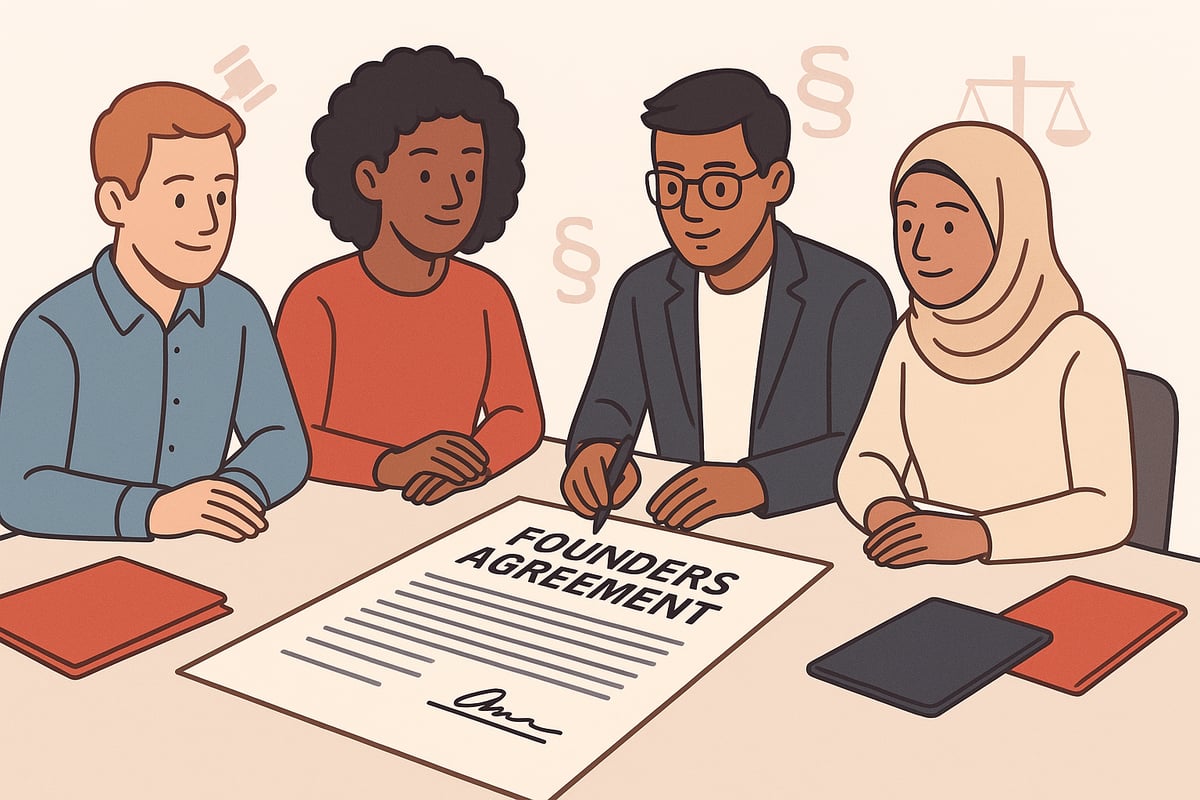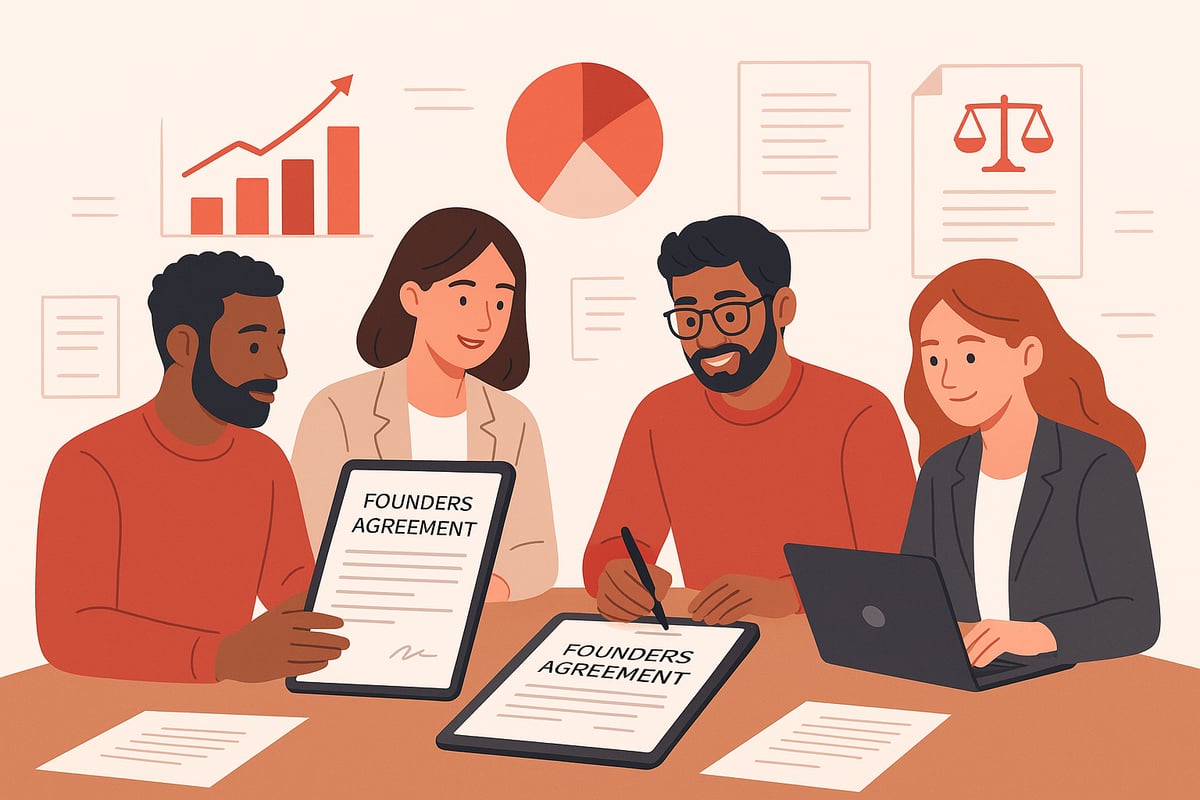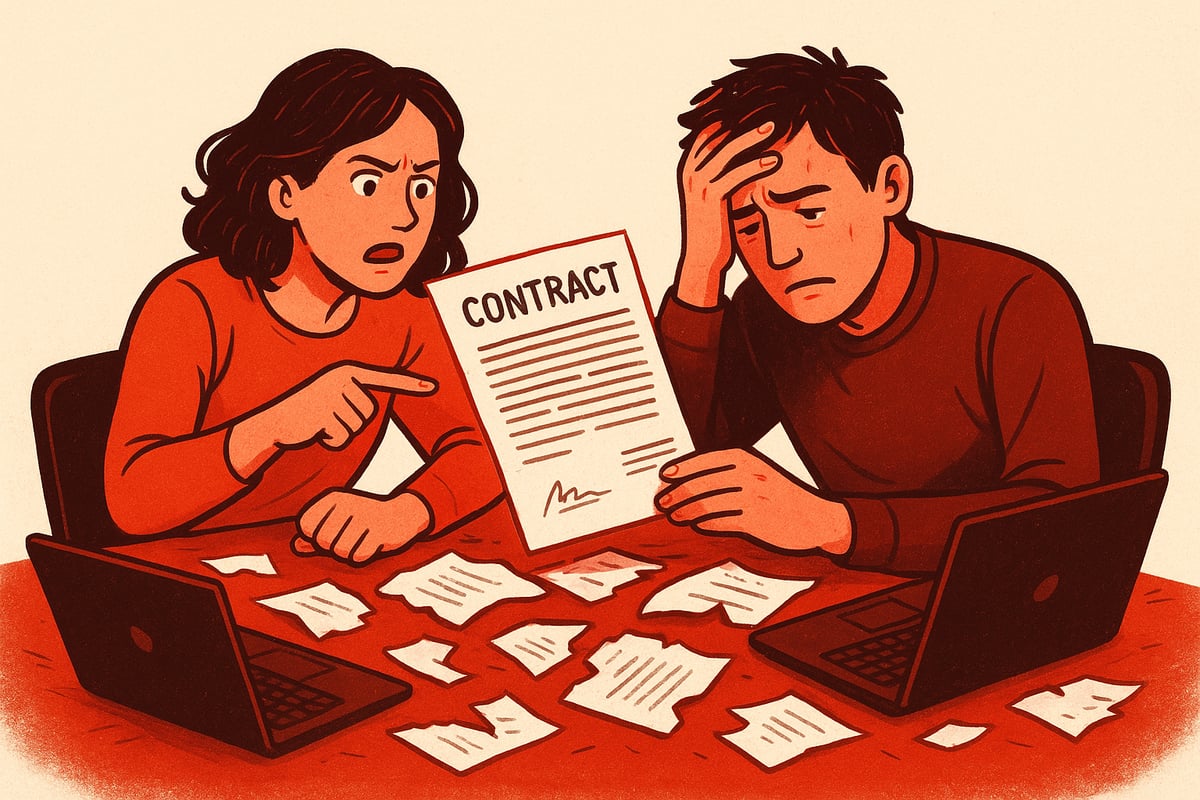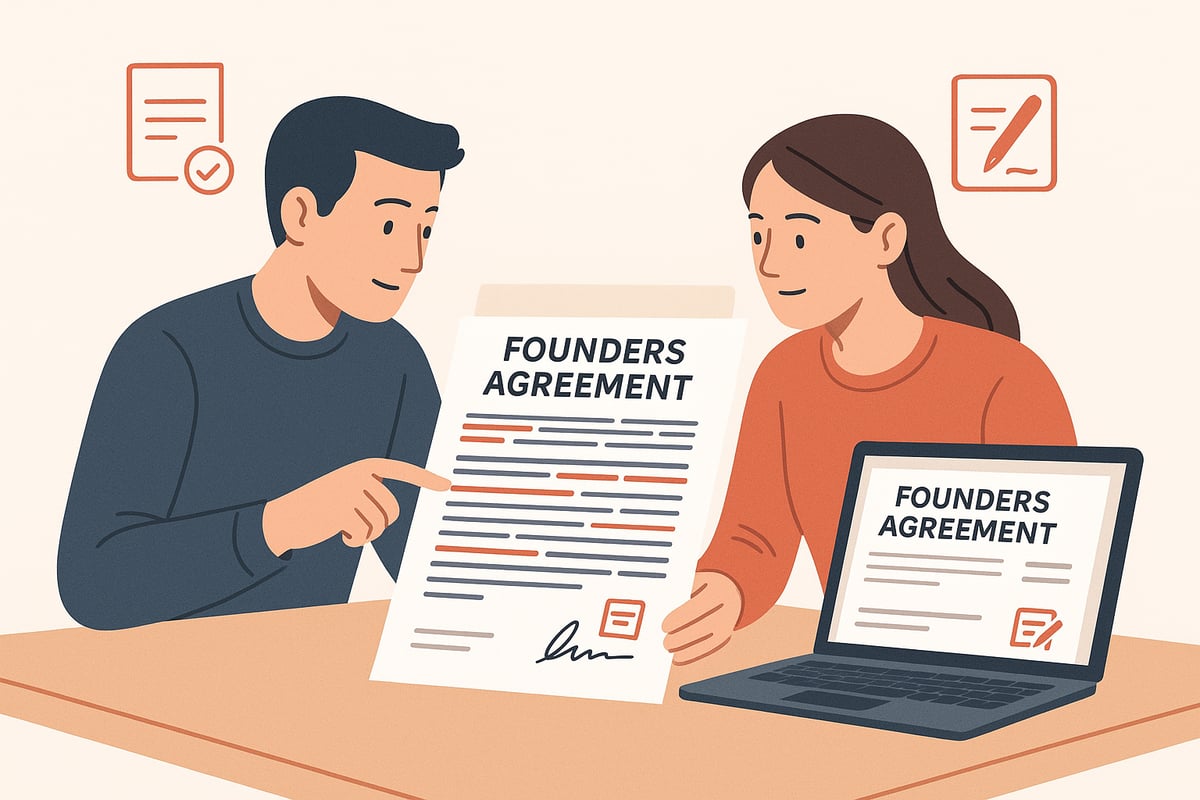Founders Agreement Guide: Essential Steps for 2025 Success
Launching a startup in 2025? The difference between thriving and failing often comes down to one document: your founders agreement.
Did you know over 65% of startup failures are linked to founder conflict or unclear agreements? Skipping a founders agreement can lead to lost equity, legal battles, and even the end of your business.
This guide will show you exactly how to create a robust founders agreement for 2025. You’ll get step-by-step instructions, negotiation tips, common pitfalls, and the latest legal trends. Set your team up for clarity, peace of mind, and long-term growth.
Understanding the Founders Agreement: Definition, Purpose, and Legal Standing
Launching a startup without a clear founders agreement is like building a house without a blueprint. At its core, a founders agreement is a foundational contract between startup founders that outlines each person’s rights, responsibilities, and contributions. It sets the tone for the business relationship, ensures everyone is on the same page, and acts as a safety net if things go sideways. The founders agreement covers everything from ownership structure to intellectual property rights and decision-making authority, making it an essential document for any new venture.
A founders agreement is not just a handshake or informal promise. It is a legally binding contract when properly drafted and signed by all parties. This document can be enforced in court and is recognized in Switzerland and most international jurisdictions. Ideally, founders should create their agreement before launching the company, but it can be adapted as the business grows or new partners join. Early drafting helps prevent misunderstandings and protects everyone’s interests from day one.
It’s easy to confuse a founders agreement with other legal documents, but each serves a unique role. For clarity, here’s a quick comparison:
| Agreement Type | When Used | Main Focus |
|---|---|---|
| Founders Agreement | Pre-launch, early stage | Roles, equity, IP, decision-making |
| Shareholders Agreement | Post-incorporation | Shareholder rights, transfer of shares |
| Operating Agreement | After legal entity formed | Internal management, profit/loss allocation |
A founders agreement is typically created before incorporation, while a shareholders agreement comes after the company is legally formed. For example, a founders agreement might state how equity is divided and what happens if a founder leaves, while a shareholders agreement governs how shares can be sold or transferred.
The legal enforceability of a founders agreement is significant. In Switzerland, these agreements are considered contracts and are protected under contract law, provided they meet legal requirements. Internationally, most jurisdictions also recognize them. Imagine two scenarios: In the first, the founders have a signed agreement clarifying roles and equity, so when a dispute arises, they resolve it quickly and fairly. In the second, there is no agreement, leading to confusion, lost friendships, and even legal battles. To dive deeper, consider exploring this Masterclass on founders agreements for practical guidance on drafting a solid agreement.
A well-crafted founders agreement is your startup’s anchor. It sets expectations, protects your ideas, and enables smoother collaboration, giving your team the clarity and confidence needed to build something great.

Step-by-Step Guide: Drafting a Comprehensive Founders Agreement in 2025
Creating a strong founders agreement in 2025 starts with a clear, step-by-step approach. The right process ensures every founder is protected and your startup is built on solid ground. In this roadmap, you will find practical, actionable steps for drafting a founders agreement that fits modern legal trends and digital business realities.
If you want a deeper dive into each phase, consider reading this How to Create a Founders Agreement guide for extra context and examples.

Step 1: Identify All Founders and Define Company Details
Begin your founders agreement by listing every founder with their full legal name, address, and contact information. Include the company’s name, even if it is only provisional at this stage. If a founder is left out or their details are incorrect, key parts of your agreement can become invalid.
Clarity here prevents disputes about who is officially a founder. The founders agreement should also note the company’s business purpose, location, and planned jurisdiction.
Missing these details can create confusion later, especially if your startup pivots or adds new founders. Taking the time to get this right makes the rest of your founders agreement much easier to enforce.
Step 2: Allocate Equity and Establish Ownership Structure
Deciding how to split ownership is a crucial part of your founders agreement. Will you divide equity equally, or base it on each founder’s role, skills, and investment? Discuss and document your approach clearly.
Most startups use vesting schedules, such as a four-year vesting with a one-year cliff, to protect against early departures. This way, if a founder leaves early, unvested shares return to the company.
Ask questions like, “What happens to shares if someone resigns today?” Your founders agreement should define these scenarios in detail, using real numbers and terms everyone understands.
Step 3: Define Roles, Responsibilities, and Decision-Making Authority
A founders agreement works best when every founder knows their role. Assign titles such as CEO or CTO, and write down each person’s key responsibilities. This keeps the team aligned and prevents power struggles.
Outline your decision-making process. Will you require a unanimous vote for big changes or allow a majority? Decide how to handle disagreements and include a dispute resolution clause.
For example, clarify who approves new hires or large expenses. The founders agreement must make these processes transparent to avoid confusion as your startup grows.
Step 4: Intellectual Property Assignment and Confidentiality
Protecting your business ideas is vital. Your founders agreement should state that all intellectual property created by founders belongs to the company. This includes inventions, code, trademarks, and patents.
Include a clear IP assignment clause and confidentiality obligations for every founder. Spell out what happens to company IP if a founder leaves. Can they use inventions they created while at the startup?
A strong founders agreement will prevent legal headaches over ownership, even years down the line. Make sure these points are not left vague.
Step 5: Handling Founder Departures, Buyouts, and Exit Scenarios
Plan for the unexpected. Your founders agreement needs to describe what happens if a founder leaves voluntarily, is removed, or wants to sell their shares. Outline buyout terms, valuation methods, and any non-compete requirements.
Will departing founders keep unvested equity, or does it return to the company? Decide if equity accelerates or is forfeited.
These terms protect the startup from instability and ensure fairness for everyone. With a robust founders agreement, you avoid last-minute confusion and emotional disputes during tough transitions.
Step 6: Compensation, Contributions, and Expense Policies
Be upfront about money. The founders agreement should state whether founders receive salaries from day one, or if compensation is delayed until funding arrives. Define reimbursement policies for expenses and how capital contributions are handled.
Clarify the difference between sweat equity and cash investment. Will some founders contribute more time, while others invest funds?
A transparent founders agreement ensures no one feels undervalued or surprised by financial arrangements as your startup matures.
Step 7: Amendments, Dispute Resolution, and Legal Review
Your founders agreement should include a process for making changes. Will amendments require unanimous approval, or just a majority? Document this clearly.
Add mediation or arbitration clauses to resolve conflicts quickly and fairly. Stress the importance of regular legal reviews—laws change, and your agreement must stay current.
Consult legal counsel before finalizing your founders agreement. Set a schedule to review the document annually or after major milestones.
Common Mistakes and Pitfalls to Avoid in 2025
Launching a startup is exhilarating, but even the most promising ventures can unravel if you overlook key steps. A poorly crafted founders agreement remains one of the most common reasons startups face internal conflict, legal headaches, and even collapse.

Frequent Mistakes in Your Founders Agreement
Many founders fall into the same traps when drafting their agreement:
- Skipping Vesting Schedules: Without vesting, a departing founder might walk away with a large equity stake, regardless of their contribution. Imagine a team member leaving after three months but retaining 30% ownership—this can cripple future fundraising.
- Unclear Roles and Responsibilities: When roles are vague, founders may duplicate efforts or neglect critical tasks. One startup saw both founders assume the other was handling investor outreach, leading to missed opportunities.
- Ignoring IP Ownership: Failing to clarify who owns intellectual property can spark disputes, especially if a founder leaves and claims rights to core technology.
- Not Updating the Agreement: As your startup evolves, so should your founders agreement. Outdated terms can trigger confusion during pivots or growth phases.
Here's a quick look at the most common mistakes and their fixes:
| Mistake | Impact | Solution |
|---|---|---|
| No vesting schedule | Founder leaves, keeps large stake | Include 4-year vesting, 1-year cliff |
| Vague roles | Overlaps, missed tasks | Define clear titles and duties |
| Missing IP clauses | Disputes over tech or branding | Assign all IP to the company |
| Never updating agreement | Legal gaps, misaligned interests | Review and revise annually |
How These Pitfalls Hurt Startups
The consequences are real. Over 50% of startups report founder conflict as their top challenge. One entrepreneur shared, “Entrepreneurs stop thinking about the vision of their companies and begin to think about themselves,” highlighting how poor agreements shift focus from growth to infighting.
Legal disputes can drain resources and even end friendships. In some cases, a missing clause in the founders agreement led to years of litigation, stalling product development and eroding team morale.
Actionable Solutions for 2025
You can sidestep these pitfalls with a proactive approach:
- Draft your founders agreement early, ideally before launch.
- Use vesting schedules to align long-term commitment.
- Assign and document all intellectual property clearly.
- Define roles, decision-making, and dispute resolution processes.
- Schedule regular reviews and updates, especially after funding rounds or team changes.
- Prioritize transparency—share drafts, encourage feedback, and document every change.
For a deeper dive into legal essentials and practical steps, check out the Legal basics for startups guide. It covers what every founder should know to build a solid, future-proof agreement.
By learning from common mistakes, keeping your founders agreement up to date, and fostering open communication, you safeguard both your business and your team’s relationships. The right agreement is not just paperwork—it’s your startup’s safety net for 2025 and beyond.
Key Clauses Every 2025 Founders Agreement Must Include
A robust founders agreement is only as strong as the clauses it contains. Including clear, well-defined terms will help prevent confusion, protect your startup, and keep your team aligned as you scale. Let us walk through the essential clauses every founders agreement needs in 2025.

1. Equity Split
Spell out exactly how much ownership each founder receives. Will shares be divided equally, or based on roles and contributions? For clarity, use a statement like:Each founder shall receive X% of the company’s equity, as detailed in Schedule A.
2. Vesting Schedule
Protect your startup from early departures with a vesting schedule. A common approach in a founders agreement is four-year vesting with a one-year cliff. For example:Founder shares will vest over four years, with 25% vesting after year one and the remainder monthly.
3. Intellectual Property (IP) Assignment
All founders must assign IP created for the startup to the company. This prevents future disputes and ensures your product remains protected.All intellectual property developed by founders related to the business shall be assigned to the company.
A strong IP clause means that even if a founder exits, the company retains full rights.
4. Confidentiality
Safeguard sensitive information with a confidentiality clause. This covers trade secrets, business plans, and customer data.Founders agree to keep all company information confidential, during and after their involvement.
5. Non-Compete and Non-Solicit
Limit founders from joining or starting competing ventures and from poaching clients or staff.For 12 months post-departure, founders shall not engage in competing businesses or solicit employees.
6. Roles and Decision-Making
Define who does what and how decisions are made. Assign titles, clarify authority, and establish voting rules.Decisions regarding hiring, spending over $10,000, or strategic pivots require unanimous founder approval.
For more on this, explore Co-founder and founder roles.
7. Founder Departure and Exit Terms
Detail what happens if a founder leaves. Address voluntary exits, removal, buyouts, and equity forfeiture or acceleration.If a founder departs, unvested shares are forfeited unless otherwise agreed. Buyout terms shall follow the company’s fair market value.
8. Dispute Resolution
Add a clause for resolving disagreements, such as mediation or arbitration, to avoid costly litigation.Any disputes arising from this founders agreement shall be resolved via binding arbitration.
Here is a quick summary:
| Clause | Purpose | Sample Term |
|---|---|---|
| Equity Split | Ownership division | X% per founder |
| Vesting Schedule | Protect against early exits | 4-year vesting, 1-year cliff |
| IP Assignment | Company owns all IP | All IP assigned to company |
| Confidentiality | Protect sensitive info | Info kept confidential |
| Non-Compete | Prevent competing ventures | No competition for 12 months |
| Roles & Decisions | Define authority, prevent deadlocks | Unanimous vote for key actions |
| Founder Exit | Handle voluntary/involuntary departures | Buyout based on market value |
| Dispute Resolution | Resolve disagreements efficiently | Binding arbitration |
For a deeper dive into required terms, the Key Terms to Include in a Founders' Agreement resource is invaluable.
2025 Trends and Legal Updates
Modern founders agreements now include clauses for digital signatures, remote teams, and cross-border founders. Ensure your agreement addresses GDPR and local data protection, especially if operating internationally. Using a Founder Agreement Template with Vesting (2025) can help you stay up to date with legal standards and best practices.
A well-crafted founders agreement with these clauses gives your startup a solid legal and operational foundation for 2025 and beyond.
Founders Agreement FAQs and 2025 Best Practices
Launching a startup means navigating a maze of questions, especially about your founders agreement. Getting clear answers is not just helpful, it is essential for long-term success. This section tackles the most common founders agreement FAQs and shares actionable best practices for 2025.
Frequently Asked Questions About the Founders Agreement
Here are answers to the questions founders ask most often when creating or updating a founders agreement:
| Question | Quick Answer |
|---|---|
| Is a founders agreement legally binding? | Yes, if properly drafted and signed, it is enforceable in most jurisdictions. |
| Can I use a template? | Yes, but always customize and review for your unique situation. For practical examples, see Founders' Agreement: 13 Components to Include. |
| How often should we update? | Review your founders agreement at least once a year or after major changes. |
| What if we are based in different countries? | Address international legal nuances, as rules can differ between Switzerland, the EU, and the US. |
| Can we update the agreement later? | Yes, include an amendment clause and get all founders to agree and sign. |
A founders agreement should be drafted as early as possible, ideally before any major business activity begins.
2025 Compliance Checklist
Staying compliant in 2025 means keeping your founders agreement up to date and regionally appropriate. Here is a simple checklist to guide you:
- Have all founders signed the agreement?
- Does it clearly outline roles, equity, vesting, and IP?
- Are digital signatures legally valid in your jurisdiction?
- Have you included data protection and remote work clauses?
- Is your agreement aligned with local laws? For Swiss-specific legal requirements, reference Setting up a business in Switzerland.
- Is there a process for regular reviews and amendments?
Using this checklist helps ensure your founders agreement protects everyone involved.
Best Practices and Legal Nuances
For startups with international teams, understand that a founders agreement might be interpreted differently in Switzerland, the EU, or the US. Always adapt your agreement to local laws and seek legal review from a professional familiar with your target region.
Regularly revisit your founders agreement as your company grows or pivots. If you face complex decisions, founder disputes, or international expansion, consult legal counsel early.
A strong founders agreement is not just a legal formality, it is your startup’s safety net and growth engine for 2025.
Ready to put all these founders agreement insights into action for your own startup? If you want extra clarity and real-world advice tailored for Swiss founders, you don’t have to do it alone. I recommend checking out Swisspreneur’s free masterclasses—they dive deep into legal essentials and guide you step by step, so you can avoid rookie mistakes and set your team up for long term success in 2025. Plus, you’ll get tips from experienced entrepreneurs who’ve been where you are now.
Watch our free masterclasses

